Abstract
Amoxicillin and clavulanic acid are prescribed as a fixed drug combination. The purpose of the present study was to assess the influence of various degrees of renal insufficiency (glomerular filtration rate [GFR], less than 5 to greater than 75 ml/min per 1.73 m2) on the pharmacokinetics of amoxicillin and clavulanic acid following oral (500 and 125 mg of amoxicillin and clavulanic acid, respectively) and intravenous (1,000 and 200 mg, respectively) dosing. The volume of distribution and the systemic availability were independent of the renal function, while the total body clearance and the renal and the nonrenal clearance of amoxicillin and clavulanic acid decreased with decreasing renal function. The decrease in the total body clearance was more pronounced for amoxicillin than for clavulanic acid. This explains the increase in the ratio of the area under the plasma concentration versus time curve of amoxicillin to that of clavulanic acid with decreasing glomerular filtration rate after oral dosing; for example for a GFR of 75 ml/min, the ratio of amoxicillin to clavulanic acid was 4.9 +/- 1.2; for a GFR of 35 to 75 ml/min, 5.3 +/- 2.4; for a GFR of 10 to 35 ml/min, 11.9 +/- 5.8; for a GFR of 5 to 10 ml/min, 13.4 +/- 9.1; and for patients on hemodialysis, 14.7 +/- 5.3. Dosage recommendations are suggested which prevent undue accumulations of amoxicillin while maintaining adequate concentrations of clavulanic acid.
Full text
PDF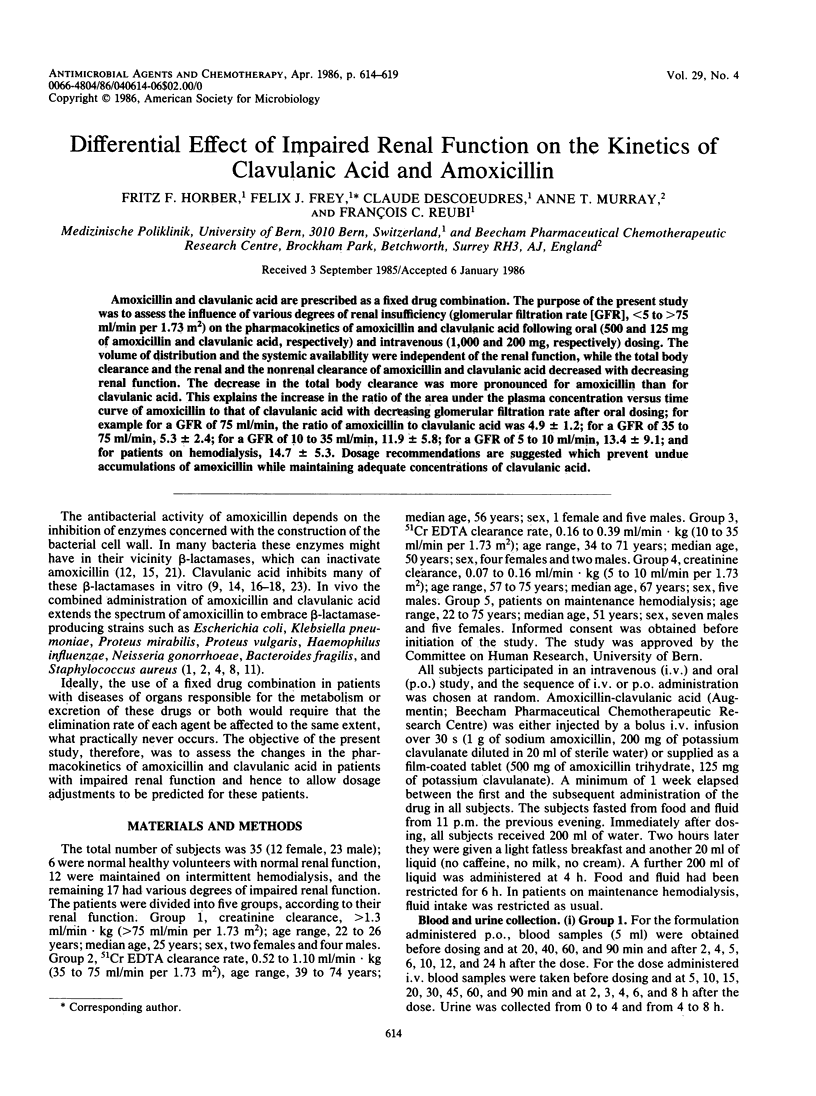
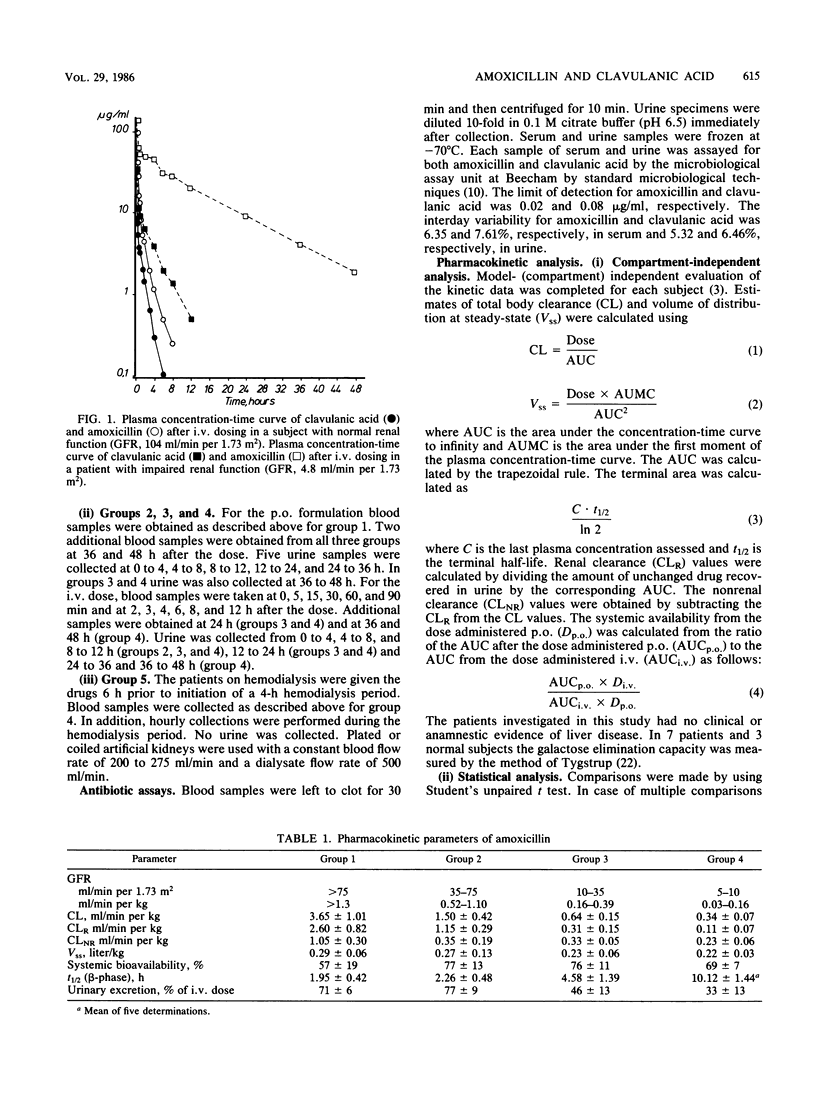
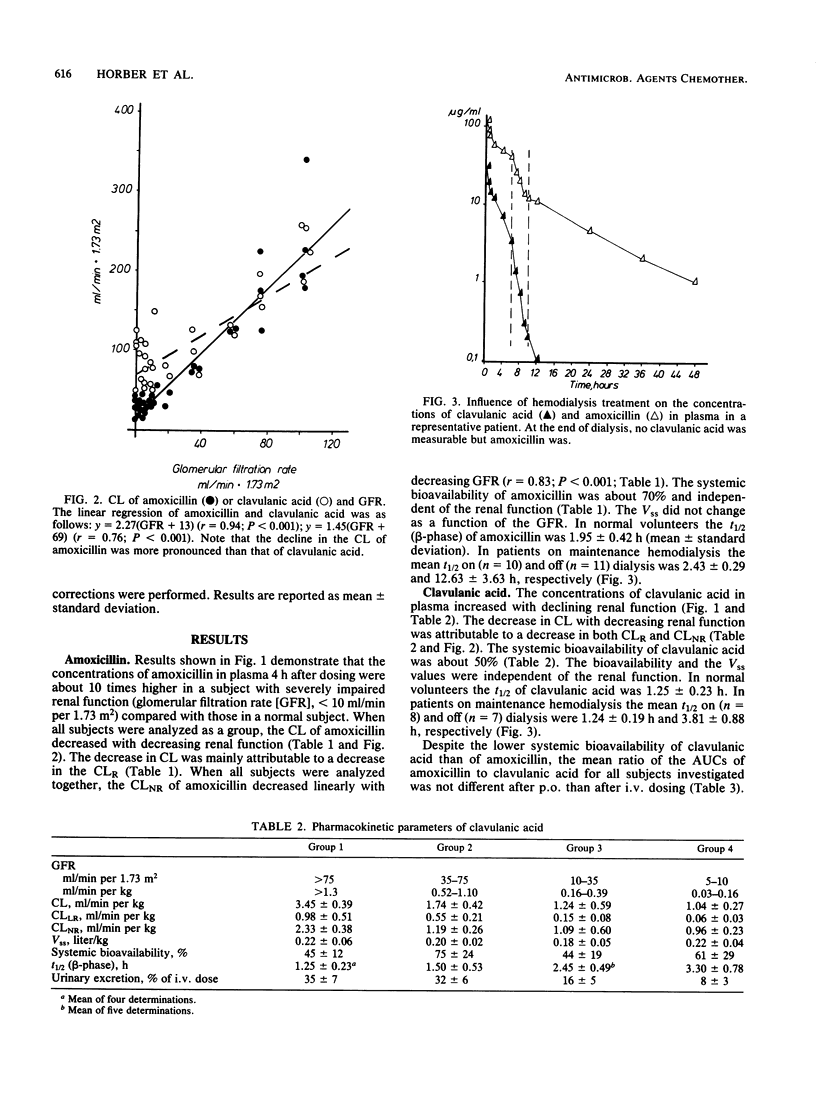
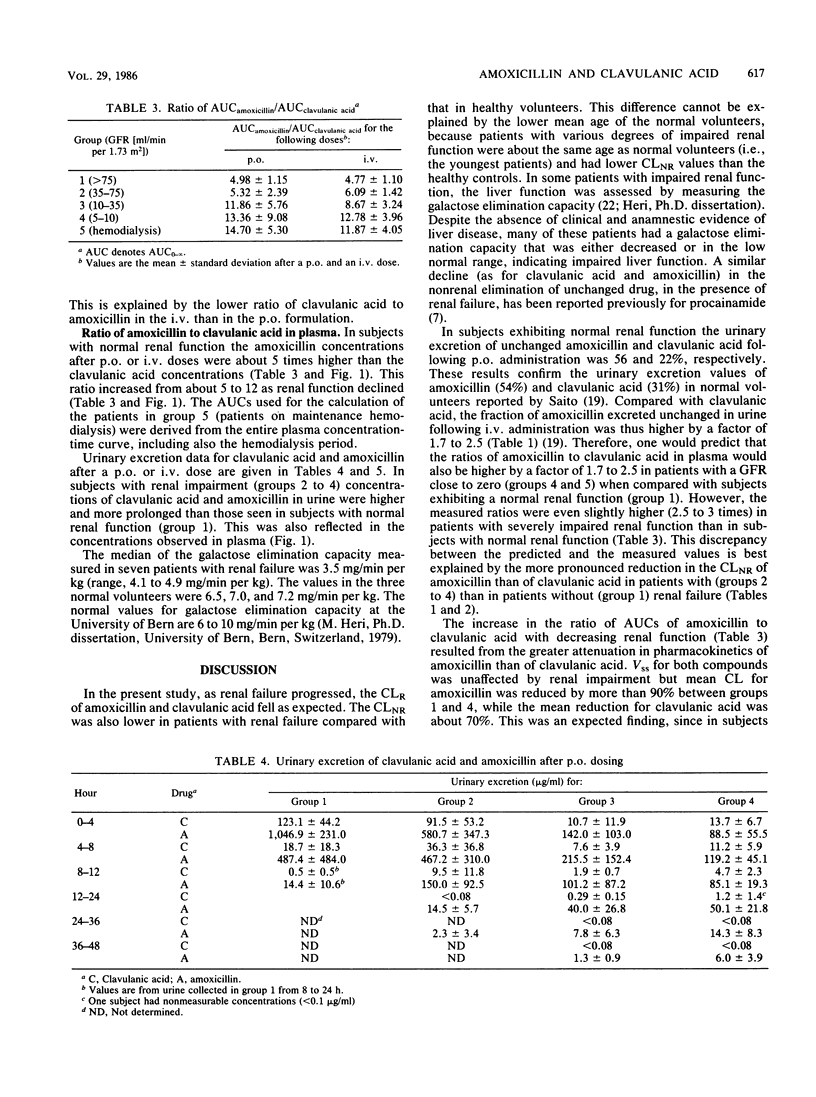
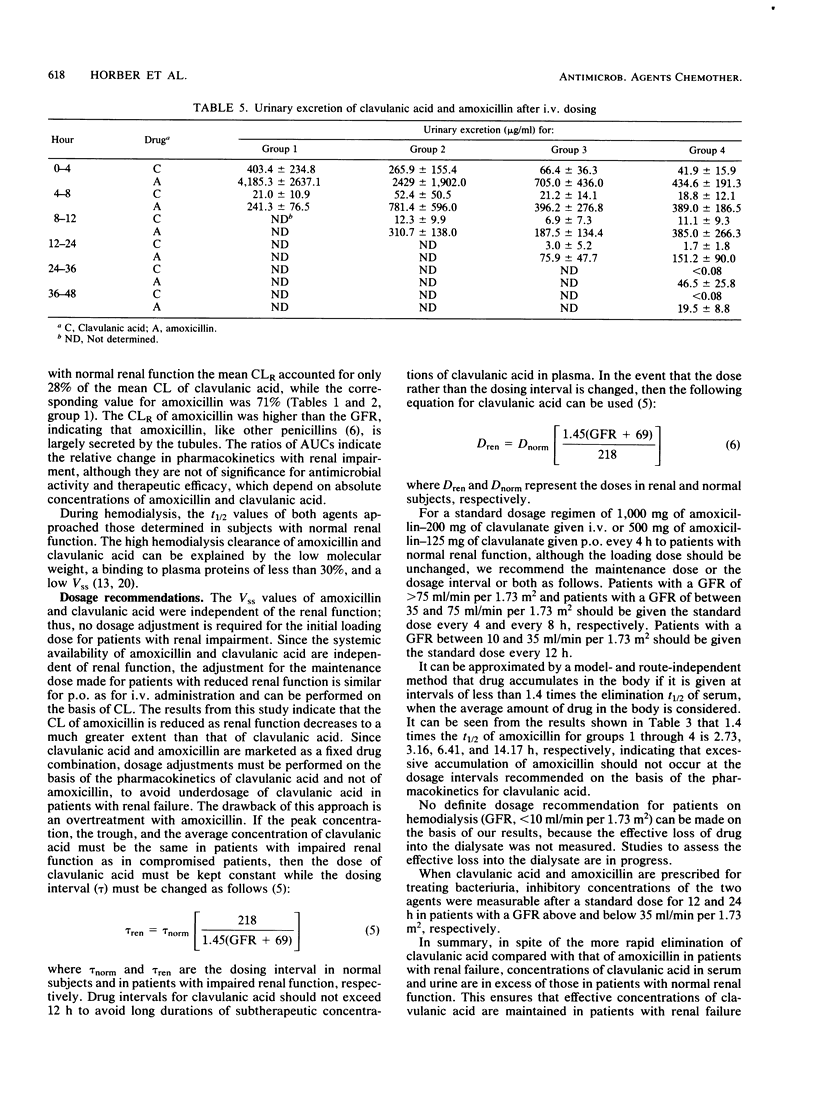
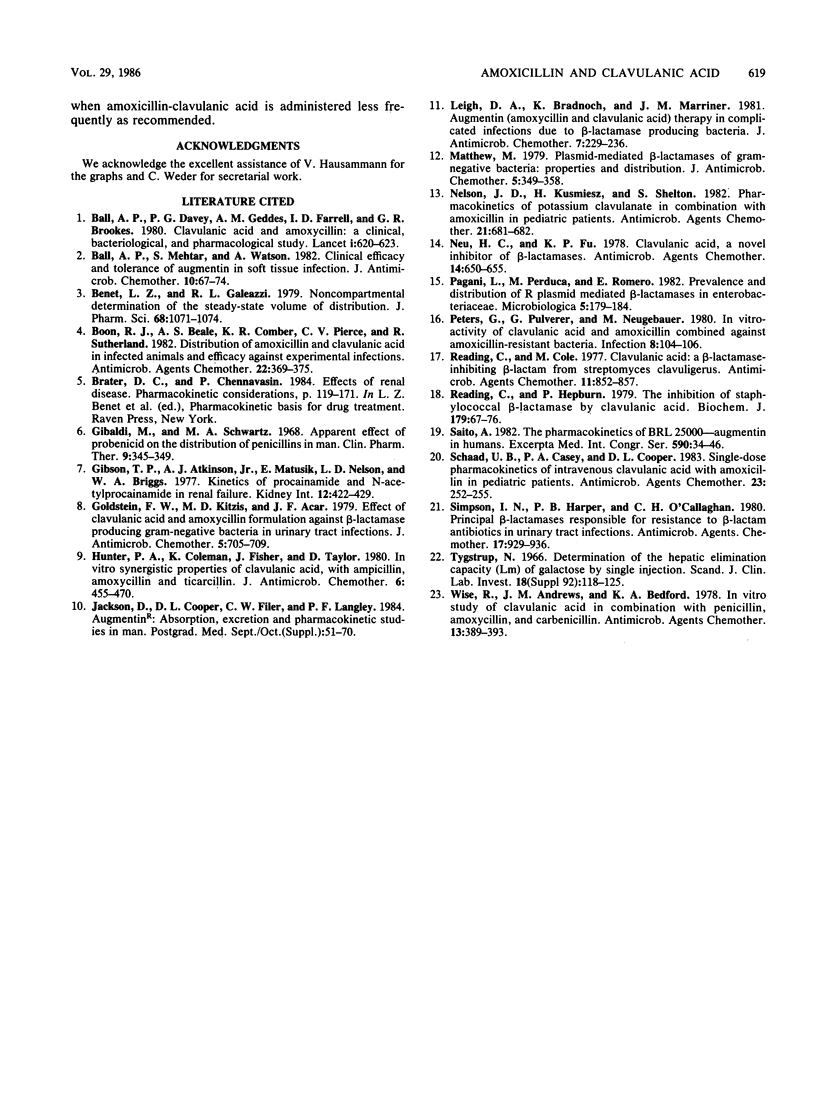
Selected References
These references are in PubMed. This may not be the complete list of references from this article.
- Ball A. P., Geddes A. M., Davey P. G., Farrell I. D., Brookes G. R. Clavulanic acid and amoxycillin: a clinical, bacteriological, and pharmacological study. Lancet. 1980 Mar 22;1(8169):620–623. doi: 10.1016/s0140-6736(80)91118-6. [DOI] [PubMed] [Google Scholar]
- Ball A. P., Mehtar S., Watson A. Clinical efficacy and tolerance of Augmentin in soft tissue infection. J Antimicrob Chemother. 1982 Jul;10(1):67–74. doi: 10.1093/jac/10.1.67. [DOI] [PubMed] [Google Scholar]
- Benet L. Z., Galeazzi R. L. Noncompartmental determination of the steady-state volume of distribution. J Pharm Sci. 1979 Aug;68(8):1071–1074. doi: 10.1002/jps.2600680845. [DOI] [PubMed] [Google Scholar]
- Boon R. J., Beale A. S., Comber K. R., Pierce C. V., Sutherland R. Distribution of amoxicillin and clavulanic acid in infected animals and efficacy against experimental infections. Antimicrob Agents Chemother. 1982 Sep;22(3):369–375. doi: 10.1128/aac.22.3.369. [DOI] [PMC free article] [PubMed] [Google Scholar]
- Gibaldi M., Schwartz M. A. Apparent effect of probenecid on the distribution of penicillins in man. Clin Pharmacol Ther. 1968 May-Jun;9(3):345–349. doi: 10.1002/cpt196893345. [DOI] [PubMed] [Google Scholar]
- Gibson T. P., Atkinson A. J., Jr, Matusik E., Nelson L. D., Briggs W. A. Kinetics of procainamide and N-acetylprocainamide in renal failure. Kidney Int. 1977 Dec;12(6):422–429. doi: 10.1038/ki.1977.133. [DOI] [PubMed] [Google Scholar]
- Goldstein F. W., Kitzis M. D., Acar J. F. Effect of clavulanic acid and amoxycillin formulation against beta-lactamase producing Gram-negative bacteria in urinary tract infections. J Antimicrob Chemother. 1979 Nov;5(6):705–709. doi: 10.1093/jac/5.6.705. [DOI] [PubMed] [Google Scholar]
- Hunter P. A., Coleman K., Fisher J., Taylor D. In vitro synergistic properties of clavulanic acid, with ampicillin, amoxycillin and ticarcillin. J Antimicrob Chemother. 1980 Jul;6(4):455–470. doi: 10.1093/jac/6.4.455. [DOI] [PubMed] [Google Scholar]
- Leigh D. A., Bradnock K., Marriner J. M. Augmentin (amoxycillin and clavulanic acid) therapy in complicated infections due to beta-lactamase producing bacteria. J Antimicrob Chemother. 1981 Mar;7(3):229–236. doi: 10.1093/jac/7.3.229. [DOI] [PubMed] [Google Scholar]
- Matthew M. Plasmid-mediated beta-lactamases of Gram-negative bacteria: properties and distribution. J Antimicrob Chemother. 1979 Jul;5(4):349–358. doi: 10.1093/jac/5.4.349. [DOI] [PubMed] [Google Scholar]
- Nelson J. D., Kusmiesz H., Shelton S. Pharmacokinetics of potassium clavulanate in combination with amoxicillin in pediatric patients. Antimicrob Agents Chemother. 1982 Apr;21(4):681–682. doi: 10.1128/aac.21.4.681. [DOI] [PMC free article] [PubMed] [Google Scholar]
- Neu H. C., Fu K. P. Clavulanic acid, a novel inhibitor of beta-lactamases. Antimicrob Agents Chemother. 1978 Nov;14(5):650–655. doi: 10.1128/aac.14.5.650. [DOI] [PMC free article] [PubMed] [Google Scholar]
- Pagani L., Perduca M., Romero E. Prevalence and distribution of R plasmid mediated beta-lactamases in Enterobacteriaceae. Microbiologica. 1982 Jul;5(3):179–184. [PubMed] [Google Scholar]
- Peters G., Pulverer G., Neugebauer M. In vitro-activity of clavulanic acid and amoxicillin combined against amoxicillin-resistant bacteria. Infection. 1980;8(3):104–106. doi: 10.1007/BF01641472. [DOI] [PubMed] [Google Scholar]
- Reading C., Cole M. Clavulanic acid: a beta-lactamase-inhiting beta-lactam from Streptomyces clavuligerus. Antimicrob Agents Chemother. 1977 May;11(5):852–857. doi: 10.1128/aac.11.5.852. [DOI] [PMC free article] [PubMed] [Google Scholar]
- Reading C., Hepburn P. The inhibition of staphylococcal beta-lactamase by clavulanic acid. Biochem J. 1979 Apr 1;179(1):67–76. doi: 10.1042/bj1790067. [DOI] [PMC free article] [PubMed] [Google Scholar]
- Schaad U. B., Casey P. A., Cooper D. L. Single-dose pharmacokinetics of intravenous clavulanic acid with amoxicillin in pediatric patients. Antimicrob Agents Chemother. 1983 Feb;23(2):252–255. doi: 10.1128/aac.23.2.252. [DOI] [PMC free article] [PubMed] [Google Scholar]
- Simpson I. N., Harper P. B., O'Callaghan C. H. Principal beta-lactamases responsible for resistance to beta-lactam antibiotics in urinary tract infections. Antimicrob Agents Chemother. 1980 Jun;17(6):929–936. doi: 10.1128/aac.17.6.929. [DOI] [PMC free article] [PubMed] [Google Scholar]
- Tygstrup N. Determination of the hepatic elimination capacity (Lm) of galactose by single injection. Scand J Clin Lab Invest Suppl. 1966;18:118–125. [PubMed] [Google Scholar]
- Wise R., Andrews J. M., Bedford K. A. In vitro study of clavulanic acid in combination with penicillin, amoxycillin, and carbenicillin. Antimicrob Agents Chemother. 1978 Mar;13(3):389–393. doi: 10.1128/aac.13.3.389. [DOI] [PMC free article] [PubMed] [Google Scholar]


